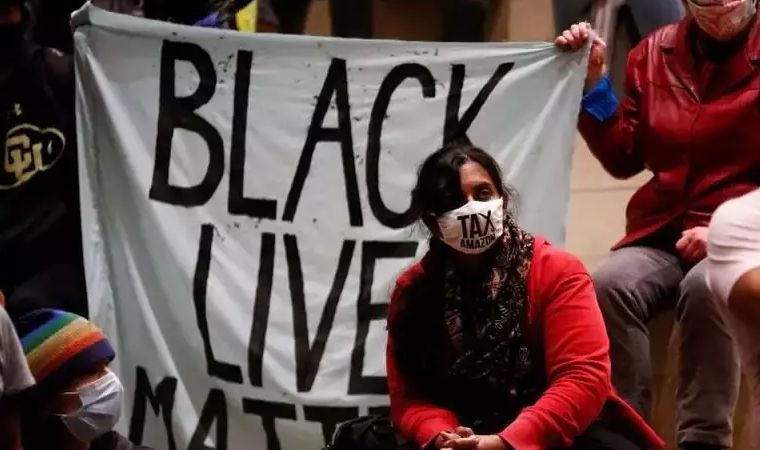 The Marikana massacre, where police armed with automatic weapons opened fire and killed 34 striking miners, was a watershed in post-Apartheid South Africa. Echoing this, one headline covering the launch read “born in post-Marikana anger, Workers & Socialist Party enters SA politics”.
The Marikana massacre, where police armed with automatic weapons opened fire and killed 34 striking miners, was a watershed in post-Apartheid South Africa. Echoing this, one headline covering the launch read “born in post-Marikana anger, Workers & Socialist Party enters SA politics”.
The most significant feature of the 2012 mineworkers’ strikes was the organisation of independent rank-and-file led strike committees outside of the existing unions and bargaining mechanisms. Across the country – in the platinum belt, the gold fields and elsewhere – shaft after shaft created their own organisation and pushed forward a new militant leadership. The National Union of Mineworkers (NUM) which had collaborated with the mine bosses were evicted at a stroke. On the initiative of the Democratic Socialist Movement (DSM, CWI South Africa) these shaft-based committees organised first across the mining heartland of Rustenburg and then into a national mineworkers strike committee.
The ANC government and their Tripartite Alliance partners – the South African Communist Party (SACP) and the Congress of South African Trade Unions (Cosatu) of which NUM is the largest affiliate – refused to support the mineworkers. Not only was support refused but the mineworkers were vilified and demonised by the very organisations that claim to represent them. There is no doubt that in their campaign against the mineworkers’ independent strike committees the groundwork for the Marikana massacre was laid. The recognition by the mineworkers that they stood alone and without a political voice was decisive in the emergence of WASP.
The mining industry is the mainstay of the SA economy and the mineworkers the backbone of the working class, but it is not just here that the class struggle rages intensely. The farmworkers of the Western Cape have risen up in several waves from late 2012 to demand higher wages. They followed the model established by the mineworkers and moved to organise independent strike committees and they too forced concessions from the government and the big business farmers. In community after community, service delivery protests are held daily, in demand of roads, sanitation, electricity and water. In Sasolburg, the community exploded in a mass movement against attempts to cut funding even further. In the public sector, under the pressure of a growing budget deficit, mighty battles over pay and outsourcing loom.
This is the South Africa that the ANC governs. Raised to power on the backs of the mass workers struggles up to 1994, its support had already eroded before Marikana for its failure to satisfy the aspirations of the masses. Now, in the aftermath of Marikana, and mired in corruption, it has lost whole swathes of its ‘traditional base’ amongst the working class and poor masses. Cosatu is riven with division and the process of disintegration is progressing. Workers are not allowing the slavish support for the Tripartite Alliance by the Cosatu leadership to hold back their struggles. New independent unions are being created and discontent amongst Cosatu rank-and-file and shop stewards is simmering.
Against this background, and with a continuing widespread support for socialism amongst the masses, the Workers & Socialist Party has emerged. The launch event and the aftermath have given a clear indication of how WASP has emerged organically from the conclusions workers have drawn from the betrayals of the ANC and the recent experience of struggle.
As one of the speakers at the launch, a workers’ committee member from the Carletonville gold mines south of Johannesburg said: “This is the time to build and prepare to fight… During the strike we saw the NUM, Cosatu, the ANC and SACP – none of them came to defend us. Instead they attacked us. It was the DSM alone that came to us when we were on the mountain, and stayed there with us to fight.”
The meeting was chaired by Weizmann Hamilton, the general secretary of the Democratic Socialist Movement (DSM). Headline speakers included Mametlwe Sebei (WASP spokesman & DSM executive member), Elias Juba (chairman of the national mineworkers committee), Ephraim Mphahlela (president of the National Transport Movement NATAWU), Elmond Magedi (Socialist Youth Movement), Liv Shange (DSM) and Joe Higgins (Socialist Party MP in Ireland).
The mineworkers embrace WASP as “our” party. It was in these terms that delegates from different mines pledged their support at the launch. Speakers included workers’ delegates from Klerksdorp Uranium, Kumba Iron Ore, Bokoni Platinum, Gold Fields KDC, Harmony Gold, the Mpumalanga coal mines and Anglo Gold Ashanti. As the launch was broadcast on TV, a mineworkers leader from a mine that was unable to attend the launch phoned to report that dozens of workers had turned up at his office demanding to know: “how do we join OUR party?!”
The president and executive members of the new National Transport & Allied Workers Union (NATAWU) attended and spoke from the top table. NATAWU is a left-split from the Cosatu-affiliated SATAWU transport union and is already out-stripping them in membership because of their willingness to decisively lead struggle in a series of strikes in the transport sector over recent weeks.
The turnout at the launch far exceeded expectations and as the hall could not accommodate the turnout and attendees over-spilled onto the neighbouring field. Pretoria/Tshwane is outside of the mining heartlands. The bulk of the 600-strong audience were Tshwane Municipality workers who, alongside the DSM, waged a struggle against dismissal and won. Hundreds walked miles in order to attend the launch of THEIR party. Already WASP is establishing itself as a party of struggle that can win victories.
Students and young people also travelled from far to attend the launch. As Elmond Magedi, a DSM activist and initiator of the new Socialist Youth Movement that is being formed, said in his speech at the launch, young people are at hit by the hardest blows of a system in crisis – mass unemployment, a dysfunctional education system, rape and violence – and have a key role to play in building WASP to fight for a socialist future.
WASP’s five point manifesto
- Kick out the fat-cats. Nationalise the mines, the farms, the banks and big business. Nationalised industry to be under the democratic control of workers and working class communities. Democratic planning of production for social need, not profit.
- End unemployment. Create socially-useful jobs for all those seeking work. Fight for a living wage of R12,500 per month.
- Stop cut-offs and evictions – for massive investment in housing, electricity, water, sanitation, roads, public transport and social services.
- For publicly funded, free education from nursery to university.
- For publicly funded free health care accessible to all.
- We reject outright the corruption of pro-capitalist politicians and political parties.
- All WASP candidates for publicly elected positions – whether councillors, MPLs or MPs – are elected subject to the right of immediate recall.
- For workers’ representatives on workers’ wages. All officials elected on the basis of the WASP manifesto will only take the wage of an average skilled worker. The remainder will be donated back to WASP.
WASP’s principles
And it is not just in South Africa that WASP is making waves. A teacher from Namibia – a member of the teachers’ worker committee – travelled days to attend the launch, despite the death of his son days earlier. Since the launch WASP has been contacted by, amongst others, a group of farmworkers and a group of health workers asking to join and help build WASP.
Big business and the capitalist class in SA recognise the discontent amongst the working class and the vacuum that exists and are scrambling desperately to renew the credibility of their system by promoting “new” faces in the ANC, the neo-liberal Democratic Alliance and now also the newly announced Agang, led by one of Africa’s richest women capitalists, Mamphela Ramphele. WASP will sting the hopes of rallying any substantial mass around such attempts. While the ruling class has mostly responded with deafening silence, the few attempts at discrediting WASP by bourgeois analysts nevertheless reflect their warranted unease.
The working class response is off to a good start with the launch. A worker from the Sishen Kumba Iron Ore mine in the Northern Cape summed up the mood in his speech – “We are so fortunate to be here today to launch our organisation which is we must build into a force to fight for us. Now we must go back to all shafts and build.”
WASP will now prepare for its next phase of development. WASP will shortly announce a date for convening of a conference to establish democratic structures, a leadership and flesh out its manifesto. There are many other fronts WASP plans to open up: a campaign to re-call corrupt councillors, taking up the issue of labour broking, the collection of one million signatures in support of WASP, and preparing the ground for a general strike should the mine bosses and government dare to enact mass retrenchments in the mining industry.



